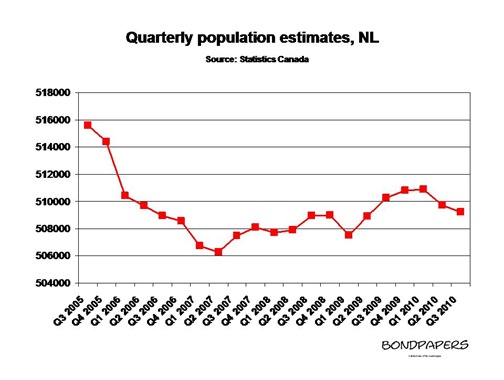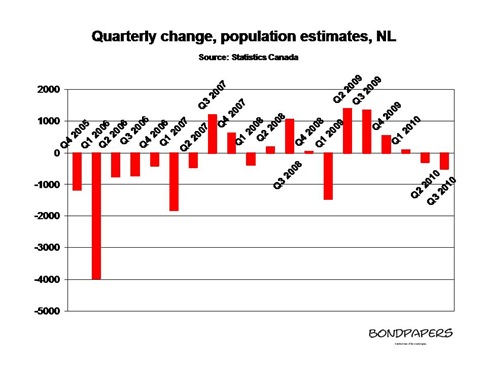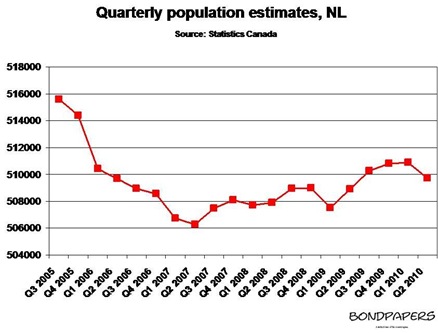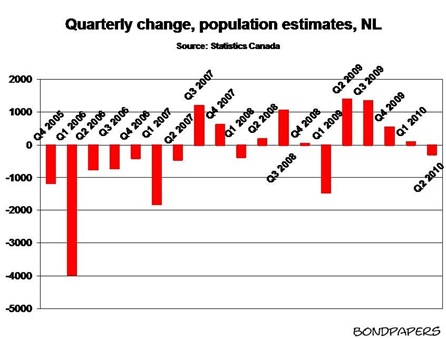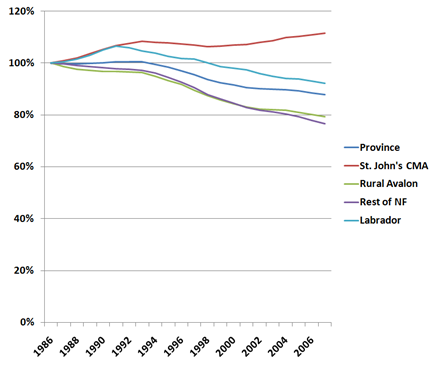While someone in the provincial government may have decided that an estimated population increase of 96 people was something to crow about, surely there is more good news than just that.
Why of course there is, as the
new release writer tells us, via a quote from the minister involved:
For seven successive quarters now, there has been a net inflow of people to the province,” said the Honourable Tom Marshall, Minister of Finance and President of Treasury Board. “This sustained gain is encouraging, and an indication that more people recognize and have confidence in the opportunities offered in Newfoundland and Labrador.”
Sure enough, if you take the Statistics Canada numbers and graph them you will see what appears to be a net increase in population over time.
As the chart shows, there has been net growth overall - not just in migration flow - in the last four quarters.
But just take a look at the drop from the third quarter in 2005; 10,000 fewer in the province by the middle of 2007 compared to two years earlier. Since then the gains have been generally more modest each quarter.
Still, it’s an upward trend and those loyal to the cause will surely take that as a good thing.
Before you get too happy, though, try graphing the change in the population each quarter compared to the one previous to it. You’ll get something that looks like this:
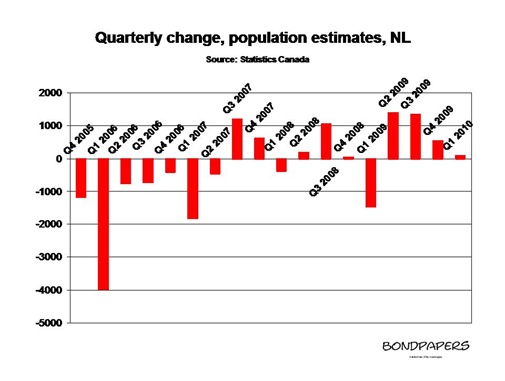
Here you’ll find something decidedly less comforting. Not only has there been a net loss in population over time, you can notice that there has been a rather precipitous drop in the rate of increase over the last three quarters. in other words, while the population is going up each quarter, it is going by less and less. First it was about 1350 or so in the second and third quarter of last year, then 533 and then a mere 96 for the first quarter of 2010.
That’s pretty much what you’ll see in the big chart of population, by the way. Think of the most trend as being potentially like a ball thrown into the air: it goes higher and higher but as it runs out of energy, it climbs less and less. Then at a point, gravity becomes the dominant force and down she comes again.
Now that may not be what is going on here, but odds are the net growth in population due to people coming here will start slowing. The growth from the middle of 2007 onwards was due entirely to Newfoundlanders and Labradorians returning home as the first casualties of an impending recession. Think of them as canaries in a coal mine.
Except for a big drop in early 2009, the population has been going up as the recession took hold nationally. Stimulus spending took a while to work into the economy so there isn’t a perfect match between the local population and the deepening of the recession. Overall though it’s a bit hard to mistake the connection between the recession on the one hand and the local growth in population.
And don’t forget, either, that the local economy actually shrank here by 10% last year. If it wasn’t for the massive government infrastructure spending, things would have been much more bleak. That public money continues to flow this year and has already been credited with driving a huge chunk of the economic growth.
It’s not like the province is an Alberta-like hotbed of private sector investment, no matter how much the provincial would like you to think otherwise.
So if things are actually getting better elsewhere, it would only make sense that the local population growth would slow down. Don’t be surprised if the population starts to drop again within the next two quarters.
On the other hand, pay attention to the news. If we are looking at a “w”-shaped recession – that is if there’s another slowdown – the population will jump up again.
And just to keep all this in perspective, take a look at an opinion piece in this weekend’s
National Post. The subject is Alberta. Note the similarity in the situation there and here:
Last week, for instance, the government crowed that it had nearly demolished the projections for the 2009-10 deficit, overspending by just $1-billion instead of the nearly $5-billion expected. The reason, however, was due to higher-than-expected royalty revenues from the oil sands, and not more careful fiscal management in Edmonton, where spending continues to swell. This year's projected deficit is still heading toward breaking red-ink records, unless serendipity again intervenes.
There are other economic indicators to examine, as the
Post piece notes, but just think about what it means when a provincial government crows about a net growth in population of a mere 96 people after a loss of 10,000 in two years.
-srbp-
